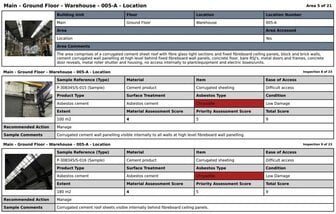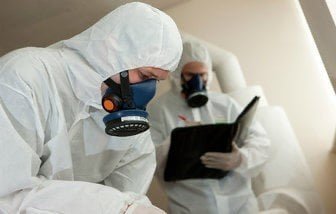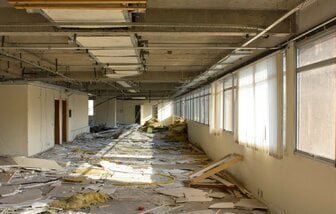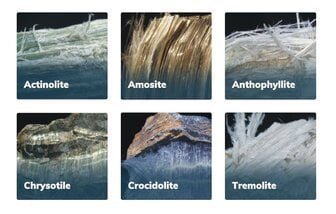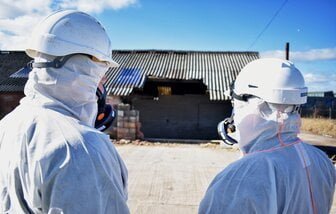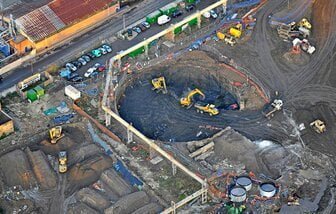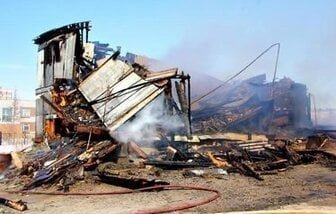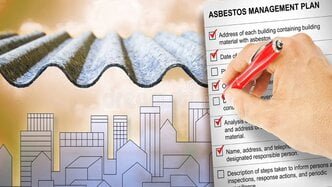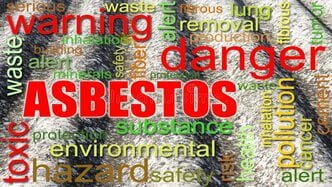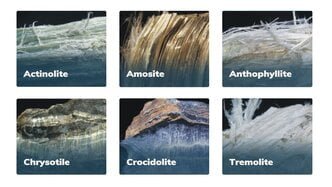Asbestos in homes in the UK
Learn about the risks of asbestos, a hazardous material commonly found in homes. This guide covers the health dangers of asbestos exposure, including asbestosis, lung cancer, and mesothelioma, and provides essential information on proper handling, safety precautions, and professional asbestos removal to safeguard your health and home
The Key to Managing Asbestos in Homes: Awareness and Proper Handling
Asbestos is a naturally occurring mineral that was commonly used in building materials for its fire-resistant and insulating properties. However, it was later discovered that exposure to asbestos fibers can cause serious health issues, including lung cancer and mesothelioma. As a result, the use of asbestos in construction materials was banned in many countries.
While the use of asbestos in new construction has been phased out, it is still present in many older homes. If you live in a house built before the 1980s, there is a possibility that it contains asbestos-containing materials (ACMs). It is important to be aware of the potential risks and know where to find asbestos in your home.
If asbestos-containing materials are found in your home, it is crucial to take appropriate measures to minimize the risk of exposure. Depending on the condition and location of the asbestos, options may include encapsulation, enclosure, or removal by a licensed abatement professional.
It is important to note that DIY asbestos removal is highly discouraged. Improper handling and removal of asbestos can lead to the release of fibers and pose a significant health risk to you and your family.
In conclusion, if you live in an older home, it is essential to be aware of the potential presence of asbestos and know where to find it. Regular inspections, proper testing, and professional assistance are key in ensuring the safety of your household. By taking appropriate measures, you can effectively manage any asbestos-related risks in your home.

FAQ – For Homeowners & Tenants
Asbestos is a naturally occurring mineral that was widely used in the construction industry until its ban in the United Kingdom in 1999. It was primarily used for its heat resistance and durability, making it a popular choice for insulation, roofing, and other building materials.
Unfortunately, asbestos poses serious health risks when its fibers are released into the air and inhaled. These microscopic fibers can become lodged in the lungs, leading to various respiratory diseases, including asbestosis, lung cancer, and mesothelioma.
Identifying Asbestos in Your Home
Given the potential dangers associated with asbestos, it is important to know whether your home contains any asbestos-containing materials (ACMs). However, it is not always easy to identify asbestos just by looking at it, as it can be mixed with other materials or hidden behind walls, ceilings, or floor coverings.
If your home was built before the year 2000, there is a possibility that it contains asbestos. Common areas where asbestos may be found include:
- Insulation boards and lagging
- Textured coatings, such as Artex
- Cement products, including roof tiles and flues
- Pipe insulation and boilers
- Vinyl floor tiles and adhesives
If you suspect that your home contains asbestos, it is recommended to seek professional help. Licensed asbestos surveyors can conduct thorough inspections and take samples for testing in an accredited laboratory.
Managing Asbestos in Your Home
If asbestos-containing materials are found in your home, it does not necessarily mean that you and your family are in immediate danger. As long as the asbestos is undisturbed and in good condition, it is generally considered safe. However, it is crucial to monitor its condition and take appropriate measures to prevent any potential exposure.
If the asbestos is damaged or deteriorating, it is highly recommended to seek professional assistance for its removal. Attempting to remove asbestos yourself can be extremely hazardous, as it can release a significant amount of fibers into the air.
When hiring an asbestos removal contractor, ensure that they are licensed and experienced in handling asbestos safely. They will follow strict guidelines and use specialized equipment to safely remove and dispose of the asbestos-containing materials.
Legal Requirements and Obligations
In the UK, there are legal obligations and regulations in place to protect individuals from the dangers of asbestos. If you are a homeowner, you have a responsibility to manage and maintain any asbestos in your property to prevent harm to yourself, your family, and any future occupants.
When selling a property, it is mandatory to provide an asbestos survey or management plan to potential buyers. Similarly, if you are a landlord, you must ensure that your property is safe for your tenants by conducting regular asbestos assessments and taking necessary actions to manage any identified risks.
Conclusion
While asbestos can be a concerning presence in older homes in the UK, proper awareness and management can help minimize the associated risks. If you suspect the presence of asbestos in your home, it is essential to seek professional assistance for proper identification, assessment, and, if necessary, removal. By taking the necessary precautions, you can ensure the safety and well-being of yourself and your loved ones.
Factors Affecting the Cost
The cost of asbestos removal can vary depending on several factors:
1. Extent of Asbestos Contamination
The size and scope of the asbestos problem in your home will have a direct impact on the cost. The more extensive the contamination, the more time, labor, and resources will be required to safely remove and dispose of the asbestos-containing materials.
2. Type of Asbestos
There are different types of asbestos, including chrysotile, amosite, and crocidolite. Each type requires specific handling procedures and safety precautions. The cost of removal may vary based on the type of asbestos present in your home.
3. Accessibility
The accessibility of the asbestos-containing materials can also affect the cost. If the asbestos is easily accessible, such as in an open area, the removal process may be less complicated and, therefore, less expensive. However, if the asbestos is hidden within walls or ceilings, the removal process may be more complex and costly.
4. Location
The location of your property can influence the cost of asbestos removal. Prices may vary depending on the region, local regulations, and the availability of qualified asbestos removal contractors.
Cost Breakdown
It is important to note that the following cost estimates are approximate and can vary significantly depending on the aforementioned factors.
1. Asbestos Survey
Prior to any removal work, it is recommended to conduct an asbestos survey to determine the presence and extent of asbestos in your home. The cost of a survey can range from £100 to £500, depending on the size and complexity of the property.
2. Asbestos Removal
The cost of asbestos removal typically includes the labor, materials, and disposal fees. On average, the removal cost can range from £1,000 to £3,000 per job. However, for more extensive asbestos contamination, the cost can be significantly higher.
3. Asbestos Disposal
Asbestos is classified as hazardous waste and must be disposed of properly. The cost of asbestos disposal can vary depending on the quantity and location. It is advisable to hire a licensed asbestos removal contractor who will ensure the safe and legal disposal of the hazardous materials.
4. Reinstatement and Repair
After the asbestos removal, reinstatement and repair work may be necessary to restore your property to its original state. The cost of reinstatement will depend on the extent of the removal work and the desired finish. It is recommended to obtain multiple quotes from reputable contractors to ensure a fair price.
Conclusion
Removing asbestos from your home is a crucial step in ensuring the safety and well-being of your family. While the cost of asbestos removal in the UK can vary depending on various factors, it is essential not to compromise on quality and compliance with safety regulations. Always choose a reputable asbestos removal contractor who can provide a detailed breakdown of the costs involved and ensure the proper removal and disposal of asbestos-containing materials.
It depends on the condition of the asbestos, and also how often the shed/garage is normally used. Asbestos is safe until it is disturbed, but then its cancer-causing fibres are released and can be inhaled. We always advise that any asbestos shed/garage should be treated with specialist interior paint to prevent fibre release
Theoretically, some asbestos removal work can be carried out by builders, such as removal of asbestos cement roofing, toilet cisterns, floor tiles, and other low-risk items. It is important to note though that in order to do so, they must meet strict legal requirements. They include:
- Having Asbestos Removal training – NOT Asbestos Awareness training.
- Holding a full Hazardous Waste Licence.
- Having ‘face fit’ tests for all his workers conducted by an accredited company.
- Carrying out the works to HSE standards.
- Using UN approved waste sacks (red & clear).
- Providing you with a genuine waste consignment note.
In our experience, we have yet to find builders who comply with all these requirements. A builder could be prosecuted for removing asbestos from your home without the necessary credentials, but remember you could be prosecuted too, as you have a legal duty to appoint only a competent and accredited company to carry out asbestos removal works from your property.
Unfortunately though, there are still far too many cowboy builders out there who remove asbestos from homes, and put both themselves and the homeowner’s family at risk.
Before considering removing asbestos yourself, it is crucial to understand the risks involved. Asbestos fibers, when disturbed, can become airborne and easily inhaled. If not handled properly, this can lead to long-term health consequences. Therefore, it is essential to take the necessary precautions to protect yourself and others.
Asbestos Removal Regulations in the UK
In the UK, the Control of Asbestos Regulations 2012 sets out the guidelines for the safe removal and handling of asbestos. According to these regulations, it is generally recommended to hire a licensed asbestos removal company to ensure the safe and legal removal of asbestos-containing materials.
The regulations distinguish between two types of asbestos removal:
- Licensed Asbestos Removal: This type of removal involves high-risk asbestos materials and requires a licensed contractor. These contractors have the necessary training, equipment, and expertise to safely remove and dispose of asbestos.
- Non-Licensed Asbestos Removal: This type of removal involves lower-risk asbestos materials that can be safely handled by non-licensed individuals. However, it is important to note that even non-licensed asbestos removal should be carried out with caution and following the appropriate guidelines.
When Can I Remove Asbestos Myself?
While it is generally recommended to hire a licensed asbestos removal company, there are specific situations where non-licensed individuals can remove asbestos themselves:
- Non-licensed asbestos removal can be considered if the asbestos-containing material is in good condition, undamaged, and not likely to be disturbed during the removal process.
- If the total area of asbestos-containing material to be removed is less than 10 square meters, non-licensed removal may be an option.
- If the asbestos-containing material is of a lower risk category, such as asbestos cement products, and appropriate precautions are taken, non-licensed removal may be permitted.
Precautions for DIY Asbestos Removal
If you decide to remove asbestos yourself, it is essential to follow these precautions:
- Wear appropriate personal protective equipment (PPE), including disposable coveralls, gloves, and a respirator mask specifically designed for asbestos.
- Wet the asbestos-containing material with a suitable water spray to minimize the release of fibers.
- Use appropriate tools to carefully remove the material without causing excessive damage or dust.
- Double-bag the removed asbestos in heavy-duty plastic bags and seal them securely.
- Arrange for the safe disposal of the asbestos waste at a licensed disposal site.
Benefits of Hiring an Asbestos Removal Company
While it may be legally permissible to remove asbestos yourself in certain situations, hiring a licensed asbestos removal company offers several advantages:
- Expertise: Licensed asbestos removal companies have the necessary training and experience to safely handle asbestos materials.
- Compliance: By hiring professionals, you can ensure compliance with all relevant regulations and guidelines.
- Insurance: Licensed asbestos removal companies typically have liability insurance, providing you with protection in case of any unforeseen incidents.
- Peace of Mind: Hiring professionals allows you to focus on other aspects of your project, knowing that the asbestos removal is being handled safely and efficiently.
Conclusion
Removing asbestos is a serious task that requires careful consideration and adherence to safety guidelines. While it may be possible to remove asbestos yourself in certain situations, it is generally recommended to hire a licensed asbestos removal company. Their expertise, compliance with regulations, and insurance coverage provide peace of mind and ensure the safe removal and disposal of asbestos-containing materials.
1. Roofing and Siding: Asbestos was commonly used in roofing materials, such as shingles and corrugated sheets. It was also used in siding materials, such as cement boards and shingles. Check for any signs of deterioration or damage, as this can release asbestos fibers into the air.
2. Insulation: Asbestos was widely used as insulation in homes. It can be found in various forms, including loose-fill insulation, insulation boards, and pipe insulation. Pay particular attention to areas such as attics, crawl spaces, and around heating systems.
3. Flooring: Asbestos was commonly used in vinyl flooring, especially in older homes. It can also be found in floor tiles, adhesives, and backing materials. If your flooring is in good condition and not disturbed, the risk of asbestos exposure is minimal. However, if you plan to remove or replace the flooring, it is essential to take precautions.
4. Pipes and Ducts: Asbestos-containing materials were often used to insulate pipes and ducts in older homes. These materials can deteriorate over time, releasing asbestos fibers into the air. Inspect any exposed pipes or ducts for signs of damage or deterioration.
5. Textured Ceilings and Walls: Asbestos was commonly used in textured ceilings, also known as popcorn or cottage cheese ceilings, as well as in textured wall coatings. If you have these types of finishes in your home, it is advisable to have them tested for asbestos before attempting any renovations or repairs.
There is no legal requirement for an asbestos survey on a domestic property unless it is to undergo refurbishment. If this is the case the landlord will need to commission a survey before any works are started
The Duty Holder or person responsible for maintenance should have commissioned an asbestos survey to establish this by now. If you are responsible for maintenance then this is your responsibility and you need to give us a call immediately. If this is your landlord’s role, ask him for a copy of the report.
No, many houses in the UK contain asbestos and there is no legal requirement to remove. The material just needs to be kept in good condition and away from disturbance. Please note however, that it is illegal to sell any type of asbestos product in the UK including second hand material such as roof sheets or floor tiles.
Give us a call and one of our operatives will come out and take a sample. We will then analyse the material and provide you with a certificate showing if it is asbestos free of the type and concentration of asbestos found within it.
Exit the room immediately and close the door. If possible wet a towel and place it at the bottom of the door to prevent any fibres from blowing out with the draft. Then give us a call and one of our operatives will call to assess the situation.
Yes, we can arrange for the provision of air testing in the property which will determine if there are asbestos fibres present in the air. Give us a call for further information and pricing.
Asbestos in Homes
Learn about the risks of asbestos, a hazardous material commonly found in homes. This guide covers the health dangers of asbestos exposure, including asbestosis, lung cancer, and mesothelioma, and provides essential information on proper handling, safety precautions, and professional asbestos removal to safeguard your health and home
What is a Asbestos Surveys
Learn about the different types of asbestos surveys conducted in the UK, including asbestos management surveys, asbestos refurbishment and demolition surveys, and asbestos reinspection surveys. Find out why these surveys are crucial for identifying and managing the presence of asbestos in buildings, and how they ensure the safety.
What is a Pre-Demolition Survey?
A pre-demolition survey is an essential step in any demolition project. By conducting a thorough assessment of the building or structure, potential hazards can be identified and appropriate measures can be taken to ensure a safe and efficient demolition
Refurbishment Survey
A refurbishment survey is a critical step in the refurbishment process in the UK. It helps to identify and manage the risks associated with asbestos-containing materials, ensuring the safety of workers and occupants. By engaging a qualified surveyor to conduct the survey, duty holders
Asbestos Removal
Total Asbestos is a leading asbestos removal company in the UK, offering comprehensive services including surveys, testing, and removal. With a focus on safety, regulatory compliance, and cutting-edge technology, they manage projects across residential, commercial, industrial, and public sectors.
Types of Asbestos
Asbestos has been included in many materials in the last 150 years. Three common types of asbestos can be found in buildings: Crocidolite (Blue Asbestos), Amosite (Brown Asbestos), Chrysotile (White Asbestos)
Managing Asbestos
The strategy of the HSE is to ensure that those involved in the repair, removal or disturbance of asbestos containing materials (ACMs), such as insulation coatings or insulation boards, are licensed & competent
What Is Asbestos?
Asbestos was commonly used as a construction material in the UK between the 1950s and 1980s in particular. If your home was built between these years, chances are that you are living with Asbestos
Control Of Asbestos Regulations 2012
The control of asbestos regulation 2012 came into force on 6 April 2012. In practice the changes are fairly limited. They mean that some types of non-licensed work with asbestos now have additional requirements, i.e. notification of work, medical surveillance and record keeping.
Asbestos In The Workplace
Learn about asbestos, its types, and the health risks associated with exposure. Understand the importance of managing asbestos in the workplace, the UK’s Control of Asbestos Regulations 2012, and the role of the Health and Safety Executive (HSE) in enforcing these regulations. Discover the safety measures necessary to protect workers
Brownfield Land Remediation Contractors
We have tackled some of the most complex remediation projects undertaken in the United Kingdom, surpassing industry standards. Our diverse range of experience and expertise sets us apart and we continually deliver to the highest standards
Total Asbestos Consultancy
Total Asbestos stands as a premier provider of comprehensive asbestos consultancy services across the UK. Renowned for their expertise and unwavering commitment to safety, Total Asbestos offers a wide array of services designed to address the multifaceted challenges posed by asbestos.
Asbestos Management Plan
An asbestos management plan is essential for managing asbestos-containing materials (ACMs) in buildings. It aims to protect occupants and workers from asbestos exposure through identification, assessment, and control of ACMs.
Asbestos Dangers
Learn about the dangers of asbestos, its health risks including mesothelioma and lung cancer, and how to protect yourself from exposure. Understand the regulations and laws regarding asbestos, and find resources and support for asbestos-related issues.
Types Of Asbestos
Learn about the different types of asbestos, including chrysotile asbestos, amphibole asbestos, tremolite asbestos, and anthophyllite asbestos. Understand the characteristics and health risks associated with each type of asbestos.
How To Manage Asbestos
Dealing with asbestos requires caution and adherence to proper safety procedures. Identifying asbestos and taking appropriate action is crucial to protect the health and well-being of individuals. If you suspect the presence of asbestos.
Ready to start your project?
Committed to Excellence on all levels
Let's Work Together
Please complete the form below and someone from the Total team will be in touch to discuss your asbestos requirements For urgent needs, our customer support team is available through various channels. You can reach us via phone during business hours, or through our dedicated email support. We are committed to providing timely assistance and ensuring your asbestos concerns are addressed promptly and professionally.


